*NURSING > Test Prep > Chapter 11: NSG 201H Pain Management Test prep Questions and Answers,100% CORRECT (All)
Chapter 11: NSG 201H Pain Management Test prep Questions and Answers,100% CORRECT
Document Content and Description Below
Chapter 11: NSG 201H Pain Management Test prep Questions and Answers Answers at last page Multiple Choice Identify the choice that best completes the statement or answers the question. 1. ... Which action by the nurse is the most appropriate when initiating guided imagery with a patient as a method to control pain? 1) Suggesting a place where the patient will find peace 2) Guiding the patient toward a most beautiful or peaceful place 3) Asking the patient to use progressive muscle relaxation exercises 4) Asking the patient to take slow, full diaphragmatic/abdominal breaths 2. A patient, who rates abdominal pain as a 10 on a 1 to 10 numeric scale is experiencing nausea, vomiting, and restlessness. Which conclusion is appropriate by the nurse based on the current data? 1) Acute pain 2) Chronic pain 3) End-of-life pain 4) Fibromyalgia pain 3. The nurse is caring for a patient who is experiencing acute chest pain that is rated as a 9 on a 0 to 10 pain scale. Based on this data, which medication does the nurse plan to administer? 1) Morphine 2) Ibuprofen 3) Naproxen 4) Acetaminophen 4. The nurse is teaching a class on the perception of pain. What will the nurse teach as being the second step in processing pain stimuli? 1) Thalamus 2) Limbic system 3) Cerebral cortex 4) Reticular system 5. Which nursing action will provide the patient with the most pain relief after abdominal surgery? 1) Offer pain relief before the patient complains of pain. 2) Assess the pain level every 4 hours around the clock. 3) Wait until the patient can describe the pain specifically. 4) Allow the patient to “sleep off” the anesthesia, and then offer pain medication. 6. The patient with a sprained ankle is complaining of pain in the injured area. Which term will the nurse use when documenting this patient’s pain? 1) Somatic pain 2) Visceral pain 3) Neuropathic pain 4) Physiological pain 7. Which term should the nurse use to document the maximum amount of pain is able to tolerate? 1) Allodynia 2) Hyperalgesia 3) Pain tolerance 4) Pain threshold 8. The nurse is using a nonpharmacologic method to manage a patient’s pain, and applies a unit that applies low- voltage electrical stimulation directly over the pain area. When documenting this intervention, which term is the most appropriate for the nurse to use? 1) TENS unit 2) Nerve block 3) Functional restoration 4) Cutaneous stimulation 9. The patient has pain in the lower back that radiates down the leg as the result of a herniated disk compressing the sciatic nerve that began 4 months ago. When documenting this patient’s pain, which term will the nurse use? 1) Acute somatic pain 2) Acute visceral pain 3) Acute neuropathic pain 4) Chronic neuropathic pain 10. Which type of pain syndrome should the nurse assess when providing care to a female patient? 1) Back pain 2) Interstitial cystitis 3) Cluster headaches 4) Visceral pain from the heart 11. The nurse is providing care to a postoperative patient who is getting out of bed for the first time since surgery. When conducting the pain assessment, the patient states, “It hurts, but I do not want to take any more drugs. I do not want to end up addicted.” Which response by the nurse is most appropriate? 1) “Don’t worry about getting addicted. I will make sure you don’t get addicted.” 2) “If you don’t take the pain medication on a regular schedule, you won’t get addicted.” 3) “People who have real pain are unlikely to become addicted to analgesics provided to treat the pain.” 4) “You are wise to be concerned; it is probably time to stop taking narcotics if you can manage the pain in other ways.” 12. The nurse is providing care to a patient who had an abdominal nevus removed who is reporting intense pain. Which action by the nurse is appropriate? 1) Administer the stronger analgesic ordered by the primary care provider. 2) Administer a nonnarcotic analgesic because the patient had minor surgery. 3) Notify the health-care provider that the patient's pain is excessive for the minor surgery performed. 4) Attempt to divert the patient without administering an analgesic because the surgery was so minor. 13. A nurse overhears another nurse say, “That patient is asking for pain medication again. He is constantly on the call bell, always reporting how severe his pain is, and I think he is just drug-seeking. I am going to make him wait the full 4 hours before I give this medication again.” Which action by the nurse is the most appropriate in this situation? 1) Informing the charge nurse of what was overheard 2) Reprimanding the nurse and completing an incident or variance report 3) Ignoring the situation because the patient is not this nurse’s responsibility 4) Reminding the nurse, in private, that the sensation of pain is whatever the patient says it is 14. The hospice nurse is making a home visit to a patient with terminal cancer. The patient reports poor pain control when the spouse says, “I am giving such big doses of medication, I am afraid she is going to overdose if I give her more.” Which response by the nurse is the most appropriate? 1) “You are not giving adequate pain relief, and she is in severe pain as a result.” 2) “You are wise to be concerned. These are very strong medications you’re administering.” 3) “Let's talk about the medication you’re giving and warning signs to be concerned about.” 4) “You are not giving enough pain medication, so she is in severe pain. You need to give more.” 15. The nurse finds a postoperative patient perspiring with fist clenched upon entering the room. The nurse administers routine medication and provides care. The patient is pleasant and cooperative. Which action by the nurse is appropriate? 1) Asking the patient if pain is being experienced 2) Instructing the patient to use the call bell if he experiences pain 3) Informing the patient that he looks uncomfortable and asking him to describe his pain 4) Documenting “no complaints of pain offered” and assessing that the patient is comfortable 16. The nurse is caring for a patient who is experiencing acute pain. Which action by the patient, noted by the nurse during the assessment, is considered an associated symptom of pain? 1) Crying 2) Vomiting 3) Grimacing 4) Changing position 17. The nurse is obtaining a pain history. The patient reports pain in the right ear. Which response by the nurse is the most appropriate? 1) “Is the pain minor?” 2) “Do you have anything else that hurts?” 3) “I will note that in the record. Is there anything else I should know?” 4) “Tell me more about the pain and what you do for it when it hurts.” 18. Which data collected by the nurse is nonessential when conducting a patient pain history? 1) Intensity, quality, and patterns 2) Significant other’s assessment of the pain 3) Precipitating factors, alleviating factors, and associated symptoms 4) Effects on activities of daily living, coping resources, and affective responses 19. When caring for an older adult patient who does not speak English, which assessment tool is the most appropriate for the nurse to use to assess this patient’s pain? 1) An interpreter. 2) The patient’s affect. 3) The patient’s vital signs. 4) The FACES rating scale. 20. The pain management team individualizes the analgesic regimen by guiding the adjustment of medication, dose, time intervals, and route of administration. When discussing this method of treating pain, which term is the most appropriate for the nurse to use? 1) Analgesia 2) Equianalgesia 3) Polypharmacy 4) Dose-reduction pharmacology 21. Which is the reason for the nurse to administer ibuprofen, over acetaminophen, when providing patient pain management? 1) Analgesic effects 2) Antipyretic effects 3) Anti-inflammatory effects 4) Antipyretic and anti-inflammatory effects 22. The patient reports difficulty sleeping related to anxiety. Which nonpharmacologic pain management intervention might the nurse consider performing in order to relax the patient? 1) Massage 2) Distraction 3) Acupressure 4) Acupuncture 23. The nurse administered an oral analgesic to a patient complaining of a mild-to-moderate headache. Which activity would the nurse consider to help relieve the patient’s discomfort until the analgesic takes effect? 1) Crossword puzzles 2) Slow rhythmic breathing 3) Reading or watching TV 4) Video or computer games Multiple Response Identify one or more choices that best complete the statement or answer the question. 24. The nurse is creating a pain management plan using the three-step approach for a patient with intractable pain. Which interventions should the nurse include in this plan? Select all that apply. 1) Administer an opioid analgesic first. 2) Administer a nonopioid analgesic first. 3) Administer a mild opioid analgesic last. 4) Administer analgesics upon patient request. 5) Administer a combination nonopioid-opioid second. 25. The nurse is working on the orthopedic unit, and is caring for a patient who reports back pain. Which responses by the nurse would be appropriate when caring for this patient? Select all that apply. 1) “Does anything other than your back hurt?” 2) “I'm sorry you're hurting. I want to make you feel better.” 3) “Why don't you try another position until it's time for more pain medication?” 4) “You had medication for your pain at 4 p.m., so I can't give you any more until 8 p.m.” 5) “People with back pain experience very different symptoms. Tell me more about your back pain.” 26. According to the World Health Organization Three-Step Approach, if the nurse is caring for a patient reporting mild pain that persists after using full doses of step 1 medications, which medications can the nurse administer? Select all that apply. 1) Codeine 2) Fentanyl 3) Morphine 4) Hydrocodone with ibuprofen 5) Oxycodone with acetaminophen 27. The nurse administers a nonsteroidal anti-inflammatory drug (NSAID) to a patient who is experiencing chronic pain. When teaching the patient about this medication, which effects will the nurse include in the session? Select all that apply. 1) Sedating effects 2) Analgesic effects 3) Anesthetic effects 4) Antipyretic effects 5) Anti-inflammatory effects Chapter 11: Pain Management Answer Section MULTIPLE CHOICE 1. ANS: 4 Chapter number and title: 11, Pain Management Chapter learning objective: Incorporating both pharmacologic and nonpharmacologic evidence-based interventions into a plan of care for patients with pain Chapter page reference: 179-196 Heading: Pain Management Options Integrated Processes: Nursing Process – Implementation Client Need: Physiological Integrity – Basic Care and Comfort Cognitive level: Application [Applying] Concept: Comfort Difficulty: Moderate Feedback 1 The nurse should never suggest a peaceful place, but should allow the patient to choose the place where he finds peace. 2 The nurse should never suggest a peaceful place, but should allow the patient to choose the place where he finds peace. 3 After deep breathing, the patient may be asked to use progressive muscle relaxation exercises, and then the nurse will guide the patient toward a peaceful place. 4 The nurse begins by helping the patient to relax using slow breaths. PTS: 1 CON: Comfort 2. ANS: 1 Chapter number and title: 11, Pain Management Chapter learning objective: Defining types of pain Chapter page reference: 174-177 Heading: Comprehensive Assessment Strategies for Acute and Chronic Pain Integrated Processes: Nursing Process – Assessment Client Need: Physiological Integrity – Basic Care and Comfort Cognitive level: Comprehension [Understanding] Concept: Comfort Difficulty: Easy Feedback 1 Acute pain is pain of varying severity, location, and etiology that lasts fewer than 6 months. Acute pain is often manifested by nausea, vomiting, and restlessness. 2 Chronic pain lasts longer than 6 months and persists beyond the expected period of healing. 3 End-of-life pain is pain that is associated with the process of dying. 4 Fibromyalgia pain is widespread muscular and joint pain. PTS: 1 CON: Comfort 3. ANS: 1 Chapter number and title: 11, Pain Management Chapter learning objective: Incorporating both pharmacologic and nonpharmacologic evidence-based interventions into a plan of care for patients with pain Chapter page reference: 179-196 Heading: Pain Management Options Integrated Processes: Nursing Process – Implementation Client Need: Physiological Integrity – Pharmacological and Parenteral Therapies Cognitive level: Application [Applying] Concept: Comfort Difficulty: Moderate Feedback 1 Acute pain is often treated with an opioid such as morphine. Morphine is often used to treat chest pain that is associated with a myocardial infarction. 2 Acetaminophen, ibuprofen, and naproxen are more appropriate for other types of pain, not acute chest pain. 3 Acetaminophen, ibuprofen, and naproxen are more appropriate for other types of pain, not acute chest pain. 4 Acetaminophen, ibuprofen, and naproxen are more appropriate for other types of pain, not acute chest pain. PTS: 1 CON: Comfort 4. ANS: 3 Chapter number and title: 11, Pain Management Chapter learning objective: Explaining the pathophysiologic processes that underlie the pain process Chapter page reference: 169-172 Heading: Processing Pain Messages Integrated Processes: Teaching and Learning Client Need: Physiological Integrity – Basic Care and Comfort Cognitive level: Application [Applying] Concept: Comfort Difficulty: Moderate Feedback 1 The thalamus is the main relay station for sensory information. 2 The transmission of pain moves through the limbic system after the thalamus. 3 The cerebral cortex is the second step in processing pain stimuli. 4 Transmission of pain impulses occurs in the reticular system after traveling though the thalamus as the main relay station. PTS: 1 CON: Comfort 5. ANS: 1 Chapter number and title: 11, Pain Management Chapter learning objective: Developing a comprehensive plan of nursing care for patients with pain Chapter page reference: 177-179 Heading: Nursing Management of Pain Integrated Processes: Nursing Process – Planning Client Need: Physiological Integrity – Basic Care and Comfort Cognitive level: Application [Applying] Concept: Comfort Difficulty: Moderate Feedback 1 Anticipating a patient’s pain will ensure a more manageable pain experience than waiting until the patient complains of pain. 2 If the patient is asleep, she should not be awakened simply to assess the pain every 4 hours unless there are other significant nonverbal signs during sleep that indicate that the patient is in pain. These can include grimacing, moaning, thrashing, or guarding of a surgical site. 3 Pain management needs to be implemented prior to the patient's describing specific postoperative pain, or “sleeping off” anesthesia. 4 Pain management needs to be implemented prior to the patient's describing specific postoperative pain, or “sleeping off” anesthesia. PTS: 1 CON: Comfort 6. ANS: 1 Chapter number and title: 11, Pain Management Chapter learning objective: Defining types of pain Chapter page reference: 166-169 Heading: Definitions of Pain Integrated Processes: Communication and Documentation Client Need: Physiological Integrity – Basic Care and Comfort Cognitive level: Application [Applying] Concept: Comfort Difficulty: Moderate Feedback 1 Somatic pain originates in the skin, muscles, bone, or connective tissue, and would best describe this client’s pain. 2 Visceral pain tends to be poorly located, resulting from activation of pain receptors in the organs and/or hollow viscera. 3 Neuropathic pain results from damaged or malfunctioning nerves. 4 Somatic pain is a subclassification of physiological pain, so it would be less specific to call it physiological as opposed to somatic. PTS: 1 CON: Comfort 7. ANS: 3 Chapter number and title: 11, Pain Management Chapter learning objective: Defining types of pain Chapter page reference: 172-174 Heading: Factors Shaping the Pain Experience Integrated Processes: Communication and Documentation Client Need: Physiological Integrity – Basic Care and Comfort Cognitive level: Application [Applying] Concept: Comfort Difficulty: Moderate Feedback 1 Allodynia is pain produced by nonpainful stimuli, such as the touch of wind to the area. 2 Hyperalgesia, or hyperpathia, denotes a heightened response to painful stimuli. 3 Pain tolerance is the maximum amount of pain a client can tolerate. 4 Pain threshold is the lowest amount of stimuli needed for a person to label a sensation as pain. PTS: 1 CON: Comfort 8. ANS: 1 Chapter number and title: 11, Pain Management Chapter learning objective: Incorporating both pharmacologic and nonpharmacologic evidence-based interventions into a plan of care for patients with pain Chapter page reference: 179-196 Heading: Pain Management Options Integrated Processes: Communication and Documentation Client Need: Physiological Integrity – Basic Care and Comfort Cognitive level: Application [Applying] Concept: Comfort Difficulty: Moderate Feedback 1 The unit described is a TENS unit, or transcutaneous electrical nerve stimulator, which is a form of cutaneous stimulation. 2 Nerve block is a pharmacologic treatment injecting an analgesic or steroid into the site of pain. 3 Functional restoration is a form of social therapy. 4 TENS would be the specific name of this treatment, whereas cutaneous stimulation would be a more general term. PTS: 1 CON: Comfort 9. ANS: 3 Chapter number and title: 11, Pain Management Chapter learning objective: Defining types of pain Chapter page reference: 166-169 Heading: Definitions of Pain Integrated Processes: Communication and Documentation Client Need: Physiological Integrity – Basic Care and Comfort Cognitive level: Application [Applying] Concept: Comfort Difficulty: Moderate Feedback 1 The terminology is not used to document this patient’s pain. 2 The terminology is not used to document this patient’s pain. 3 The pain is considered acute because it has lasted less than 6 months. It is neuropathic pain because it is caused by damage to the sciatic nerve. 4 The terminology is not used to document this patient’s pain. PTS: 1 CON: Comfort 10. ANS: 2 Chapter number and title: 11, Pain Management Chapter learning objective: Describing components that comprise a comprehensive pain assessment Chapter page reference: 174-177 Heading: Comprehensive Assessment Strategies for Acute and Chronic Pain Integrated Processes: Nursing Process – Assessment Client Need: Physiological Integrity – Basic Care and Comfort Cognitive level: Application [Applying] Concept: Comfort Difficulty: Moderate Feedback 1 Back pain syndrome is more common in male, not female, patients. 2 Interstitial cystitis is more common in female patients; therefore, the nurse should assess for this. 3 Cluster headache syndrome is more common in male, not female, patients. 4 Visceral pain syndrome is more common in male, not female, patients. PTS: 1 CON: Comfort 11. ANS: 3 Chapter number and title: 11, Pain Management Chapter learning objective: Developing patient educational strategies to promote self-care and improved patient outcomes Chapter page reference: 177-179 Heading: Nursing Management of Pain Integrated Processes: Communication and Documentation Client Need: Physiological Integrity – Basic Care and Comfort Cognitive level: Application [Applying] Concept: Comfort Difficulty: Moderate Feedback 1 This statement is inappropriate. 2 This statement is inappropriate. 3 Many patients worry about becoming addicted to narcotic analgesics if they are required for more than a few days. It is important for the nurse to reassure the patient by providing truthful information. 4 This statement is inappropriate. PTS: 1 CON: Comfort 12. ANS: 1 Chapter number and title: 11, Pain Management Chapter learning objective: Incorporating both pharmacologic and nonpharmacologic evidence-based interventions into a plan of care for patients with pain Chapter page reference: 177-179 Heading: Nursing Management of Pain Integrated Processes: Nursing Process – Implementation Client Need: Physiological Integrity – Pharmacological and Parenteral Therapies Cognitive level: Application [Applying] Concept: Comfort Difficulty: Moderate Feedback 1 Pain perception is what the patient says it is, and the nurse should medicate the patient based on the patient’s description of the pain, not what the nurse anticipates. If the patient reports severe pain, the nurse should administer strong analgesics. 2 Patients who have minor surgery can still experience severe pain, and administering weaker analgesics when the patient reports severe pain would not be responsible practice. 3 There is no need to notify the health-care provider unless the nurse’s assessment indicates there is something unusual occurring. 4 Diverting the patient most likely will not be effective alone, although diversion might be possible after administering the analgesic. PTS: 1 CON: Comfort 13. ANS: 4 Chapter number and title: 11, Pain Management Chapter learning objective: Developing patient educational strategies to promote self-care and improved patient outcomes Chapter page reference: 177-179 Heading: Nursing Management of Pain Integrated Processes: Communication and Documentation Client Need: Safe and Effective Care Environment – Management of Care Cognitive level: Application [Applying] Concept: Communication Difficulty: Moderate Feedback 1 Informing the charge nurse would only be necessary if the nurse who was overheard did not respond constructively to the nurse’s correction. 2 This is not an appropriate response by the nurse. 3 It is every nurse’s responsibility to speak up and advocate for the client when situations arise that place the client at risk of incorrect treatment. 4 The nurse would address the situation privately, and not in front of others at the nurses’ station. PTS: 1 CON: Communication 14. ANS: 3 Chapter number and title: 11, Pain Management Chapter learning objective: Developing patient educational strategies to promote self-care and improved patient outcomes Chapter page reference: 177-179 Heading: Nursing Management of Pain Integrated Processes: Communication and Documentation Client Need: Physiological Integrity – Basic Care and Comfort Cognitive level: Application [Applying] Concept: Comfort; Communication Difficulty: Moderate Feedback 1 This response is likely to make the spouse feel guilty and does not provide information to provide the best care possible. 2 Telling the patient’s spouse that his or her concern is warranted is untrue. 3 It is not unusual for a family caregiver to withhold medication out of fear of overdosing the cancer patient. It is important for the nurse to inform the caregiver that his feelings are not unusual, and then provide him with the information he needs to make an informed and appropriate decision that will make the client more comfortable. 4 This response is likely to make the spouse feel guilty and does not provide information to provide the best care possible. PTS: 1 CON: Comfort | Communication 15. ANS: 3 Chapter number and title: 11, Pain Management Chapter learning objective: Developing a comprehensive plan of nursing care for patients with pain Chapter page reference: 177-179 Heading: Nursing Management of Pain Integrated Processes: Nursing Process – Implementation Client Need: Physiological Integrity – Basic Care and Comfort Cognitive level: Application [Applying] Concept: Comfort Difficulty: Moderate Feedback 1 Some patients might feel that admitting to pain is a sign of weakness, and might not bring it up unless the nurse specifically refers to the patient’s apparent discomfort and asks him to describe his pain and indicates the patient's apparent discomfort. 2 Instructing the patient to use the call bell puts the responsibility for pain assessment on the patient instead of on the nurse. 3 It is the nurse’s responsibility to assess for pain and not wait for the patient to mention it. 4 The patient’s body language indicates the likelihood of pain. PTS: 1 CON: Comfort 16. ANS: 2 Chapter number and title: 11, Pain Management Chapter learning objective: Describing components that comprise a comprehensive pain assessment Chapter page reference: 166-169 Heading: Definitions of Pain Integrated Processes: Nursing Process – Assessment Client Need: Physiological Integrity – Basic Care and Comfort Cognitive level: Comprehension [Understanding] Concept: Comfort Difficulty: Easy Feedback 1 Changing position, crying, and grimacing are manners of expressing pain. 2 Symptoms that are often associated with pain include nausea, vomiting, and dizziness. 3 Changing position, crying, and grimacing are manners of expressing pain. 4 Changing position, crying, and grimacing are manners of expressing pain. PTS: 1 CON: Comfort 17. ANS: 4 Chapter number and title: 11, Pain Management Chapter learning objective: Describing components that comprise a comprehensive pain assessment Chapter page reference: 174-177 Heading: Comprehensive Assessment Strategies for Acute and Chronic Pain Integrated Processes: Nursing Process – Assessment Client Need: Physiological Integrity – Basic Care and Comfort Cognitive level: Application [Applying] Concept: Comfort Difficulty: Moderate Feedback 1 This is a closed question and will not allow the nurse to gather the information needed regarding the patient’s pain. 2 This is a closed question and will not allow the nurse to gather the information needed regarding the patient’s pain. 3 This is a closed question and will not allow the nurse to gather the information needed regarding the patient’s pain. 4 When the patient reports pain, the nurse should seek more information. When assessing pain, the nurse should assess all aspects of the pain, including character, onset, location, duration, exacerbation, relief, and radiation. PTS: 1 CON: Comfort 18. ANS: 2 Chapter number and title: 11, Pain Management Chapter learning objective: Describing components that comprise a comprehensive pain assessment Chapter page reference: 174-177 Heading: Comprehensive Assessment Strategies for Acute and Chronic Pain Integrated Processes: Nursing Process – Assessment Client Need: Physiological Integrity – Basic Care and Comfort Cognitive level: Comprehension [Understanding] Concept: Assessment; Comfort Difficulty: Easy Feedback 1 The nurse should determine all of the other factors in order to put a plan of care in place that will help the patient address and treat the pain effectively. 2 During a pain history, it is the patient’s description of the pain that is most important, not the significant other’s. 3 The nurse should determine all of the other factors in order to put a plan of care in place that will help the patient address and treat the pain effectively. 4 The nurse should determine all of the other factors in order to put a plan of care in place that will help the patient address and treat the pain effectively. PTS: 1 CON: Assessment | Comfort 19. ANS: 4 Chapter number and title: 11, Pain Management Chapter learning objective: Describing components that comprise a comprehensive pain assessment Chapter page reference: 196-199 Heading: Managing Pain in Special Populations Integrated Processes: Nursing Process – Assessment Client Need: Physiological Integrity – Basic Care and Comfort Cognitive level: Comprehension [Understanding] Concept: Comfort Difficulty: Easy Feedback 1 If an interpreter is available the nurse can ask the interpreter to discuss the pain in more detail, but the FACES rating scale will help the nurse to respond to the patient’s pain appropriately and quickly without waiting for an interpreter. 2 Affect and vital signs might not be accurate indicators of the patient’s discomfort. 3 Affect and vital signs might not be accurate indicators of the patient’s discomfort 4 An interpreter might not always be readily available, so the FACES rating scale can be used because it is not necessary to use language. PTS: 1 CON: Comfort 20. ANS: 2 Chapter number and title: 11, Pain Management Chapter learning objective: Defining types of pain Chapter page reference: 166-169 Heading: Definitions of Pain Integrated Processes: Communication and Documentation Client Need: Physiological Integrity – Basic Care and Comfort Cognitive level: Comprehension [Understanding] Concept: Comfort Difficulty: Easy Feedback 1 Analgesia is a classification of medication used for pain control. 2 The term equianalgesia refers to the relative potency of various opioid analgesics compared to a standard dose of parenteral morphine (gold standard opioid). This tool helps professionals individualize the analgesic regimen by guiding the adjustment of medication, dose, time interval, and route of administration. 3 Polypharmacy is a generic term for multiple medication administration, often used with elders who are on many medications. 4 Dose-reduction pharmacology is not terminology associated with pain management. PTS: 1 CON: Comfort 21. ANS: 3 Chapter number and title: 11, Pain Management Chapter learning objective: Examining pain management strategies Chapter page reference: 179-196 Heading: Pain Management Options Integrated Processes: Nursing Process – Planning Client Need: Physiological Integrity – Pharmacological and Parenteral Therapies Cognitive level: Comprehension [Understanding] Concept: Comfort Difficulty: Easy Feedback 1 Both ibuprofen and acetaminophen provide analgesic effects. 2 Both ibuprofen and acetaminophen provide antipyretic effects. 3 Ibuprofen is administered over acetaminophen when anti-inflammatory properties are desired for pain management. 4 While ibuprofen is administered for its anti-inflammatory properties both acetaminophen and ibuprofen have antipyretic properties. PTS: 1 CON: Comfort 22. ANS: 1 Chapter number and title: 11, Pain Management Chapter learning objective: Incorporating both pharmacologic and nonpharmacologic evidence-based interventions into a plan of care for patients with pain Chapter page reference: 179-196 Heading: Pain Management Options Integrated Processes: Nursing Process – Planning Client Need: Physiological Integrity – Basic Care and Comfort Cognitive level: Comprehension [Understanding] Concept: Comfort Difficulty: Easy Feedback 1 Massage is used for relaxation, and can be effective in helping the client who is anxious. 2 Distraction, acupressure, and acupuncture are not used for relaxation, although they can be effective in helping the patient cope with pain. 3 Distraction, acupressure, and acupuncture are not used for relaxation, although they can be effective in helping the patient cope with pain. 4 Distraction, acupressure, and acupuncture are not used for relaxation, although they can be effective in helping the patient cope with pain. PTS: 1 CON: Comfort 23. ANS: 2 Chapter number and title: 11, Pain Management Chapter learning objective: Incorporating both pharmacologic and nonpharmacologic evidence-based interventions into a plan of care for patients with pain Chapter page reference: 179-196 Heading: Pain Management Options Integrated Processes: Nursing Process – Planning Client Need: Physiological Integrity – Basic Care and Comfort Cognitive level: Application [Applying] Concept: Comfort Difficulty: Moderate Feedback 1 Reading, watching TV, video games, and crossword puzzles might exacerbate the symptoms because the patient with a headache is often more comfortable in a dark, low- stimuli environment. 2 Slow rhythmic breathing would be an effective distraction technique for a patient with a headache. 3 Reading, watching TV, video games, and crossword puzzles might exacerbate the symptoms because the patient with a headache is often more comfortable in a dark, low- stimuli environment. 4 Reading, watching TV, video games, and crossword puzzles might exacerbate the symptoms because the patient with a headache is often more comfortable in a dark, low- stimuli environment. PTS: 1 CON: Comfort MULTIPLE RESPONSE 24. ANS: 2, 3, 5 Chapter number and title: 11, Pain Management Chapter learning objective: Incorporating both pharmacologic and nonpharmacologic evidence-based interventions into a plan of care for patients with pain Chapter page reference: 179-196 Heading: Pain Management Options Integrated Processes: Nursing Process – Implementation Client Need: Physiological Integrity – Pharmacological and Parental Therapies Cognitive level: Application [Applying] Concept: Comfort Difficulty: Moderate Feedback 1. This is incorrect. An opioid analgesic is not the first choice when using the three-step approach in pain management. 2. This is correct. The first step in the three-step approach to pain management involves administering a nonopioid drug first. 3. This is correct. If the patient is still experiencing pain, the mild opioid should be replaced with a stronger opioid in step 3. 4. This is incorrect. Pain-relieving drugs should be given “by the clock” (every 3-6 hours) rather than on demand to maintain freedom from pain. 5. This is correct. If pain is not adequately controlled with this mild intervention, patients should advance to step 2 and receive a mild opioid in combination with the same or a new nonopioid drugs. PTS: 1 CON: Comfort 25. ANS: 1, 2, 5 Chapter number and title: 11, Pain Management Chapter learning objective: Developing a comprehensive plan of nursing care for patients with pain Chapter page reference: 177-179 Heading: Nursing Management of Pain Integrated Processes: Nursing Process – Implementation Client Need: Physiological Integrity – Basic Care and Comfort Cognitive level: Application [Applying] Concept: Comfort Difficulty: Moderate Feedback 1. This is correct. The nurse should inform the patient that it is the job of the nurse to work to make the patient feel better, seek more information about the type of pain the patient is experiencing, and question any other discomforts the patient may be experiencing. 2. This is correct. The nurse should inform the patient that it is the job of the nurse to work to make the patient feel better, seek more information about the type of pain the patient is experiencing, and question any other discomforts the patient may be experiencing. 3. This is incorrect. Allowing the patient to remain in pain would not be prudent practice, and would be lacking in caring. 4. This is incorrect. Allowing the patient to remain in pain would not be prudent practice, and would be lacking in caring. 5. This is correct. The nurse should inform the patient that it is the job of the nurse to work to make the patient feel better, seek more information about the type of pain the patient is experiencing, and question any other discomforts the patient may be experiencing. PTS: 1 CON: Comfort 26. ANS: 1, 4, 5 Chapter number and title: 11, Pain Management Chapter learning objective: Incorporating both pharmacologic and nonpharmacologic evidence-based interventions into a plan of care for patients with pain Chapter page reference: 179-196 Heading: Pain Management Options Integrated Processes: Nursing Process – Implementation Client Need: Physiological Integrity – Pharmacological and Parenteral Therapies Cognitive level: Application [Applying] Concept: Comfort Difficulty: Moderate Feedback 1. This is correct. If the pain persists or the pain is moderate, the second step is a weak opioid, or a combination of opioid and nonopioid medicine can be used. Codeine is a weak opioid. 2. This is incorrect. Fentanyl is a strong opioid that is not administered until step 3. 3. This is incorrect. Morphine is a strong opioid that is not administered until step 3. 4. This is correct. If the pain persists or the pain is moderate, the second step is a weak opioid, or a combination of opioid and nonopioid medicine can be used. Hydrocodone with ibuprofen is an opioid/nonopioid medicine. 5. This is correct. If the pain persists or the pain is moderate, the second step is a weak opioid, or a combination of opioid and nonopioid medicine can be used. Oxycodone with acetaminophen is an opioid/nonopioid medicine. PTS: 1 CON: Comfort 27. ANS: 2, 4, 5 Chapter number and title: 11, Pain Management Chapter learning objective: Developing patient educational strategies to promote self-care and improved patient outcomes Chapter page reference: 179-196 Heading: Pain Management Options Integrated Processes: Teaching and Learning Client Need: Physiological Integrity – Pharmacological and Parenteral Therapies Cognitive level: Application [Applying] Concept: Comfort Difficulty: Moderate Feedback 1. This is incorrect. These medications do not have sedating or anesthetic effects in most patients, although some patients might report being able to fall asleep more easily once pain is reduced. 2. This is correct. Nonsteroidal anti-inflammatory drugs (NSAIDs) have anti-inflammatory, analgesic, and antipyretic effects. 3. This is incorrect. These medications do not have sedating or anesthetic effects in most patients, although some patients might report being able to fall asleep more easily once pain is reduced. 4. This is correct. Nonsteroidal anti-inflammatory drugs (NSAIDs) have anti-inflammatory, analgesic, and antipyretic effects. 5. This is correct. Nonsteroidal anti-inflammatory drugs (NSAIDs) have anti-inflammatory, analgesic, and antipyretic effects. PTS: 1 CON: Comfort [Show More]
Last updated: 1 year ago
Preview 1 out of 34 pages

Reviews( 0 )
Document information
Connected school, study & course
About the document
Uploaded On
Sep 23, 2022
Number of pages
34
Written in
Additional information
This document has been written for:
Uploaded
Sep 23, 2022
Downloads
0
Views
67

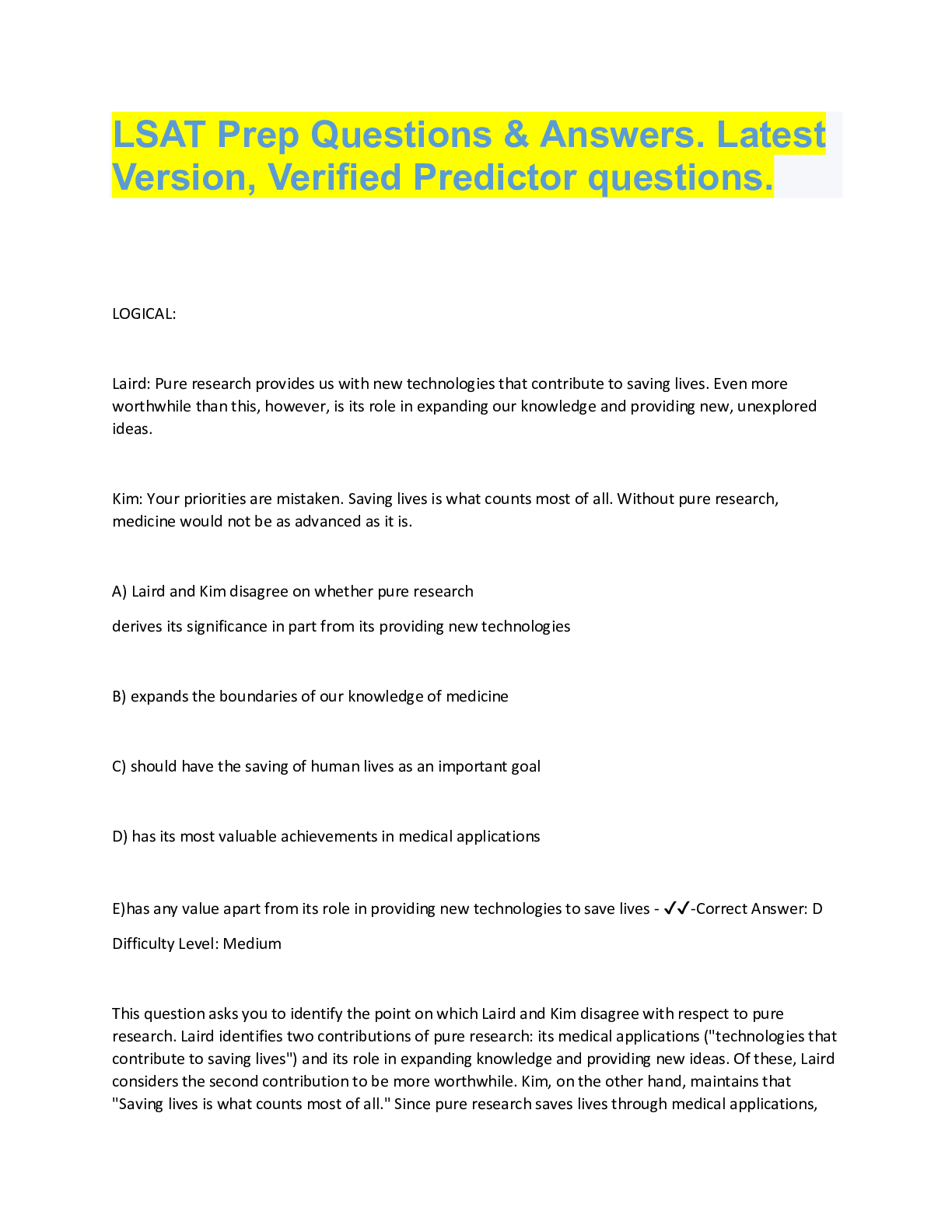
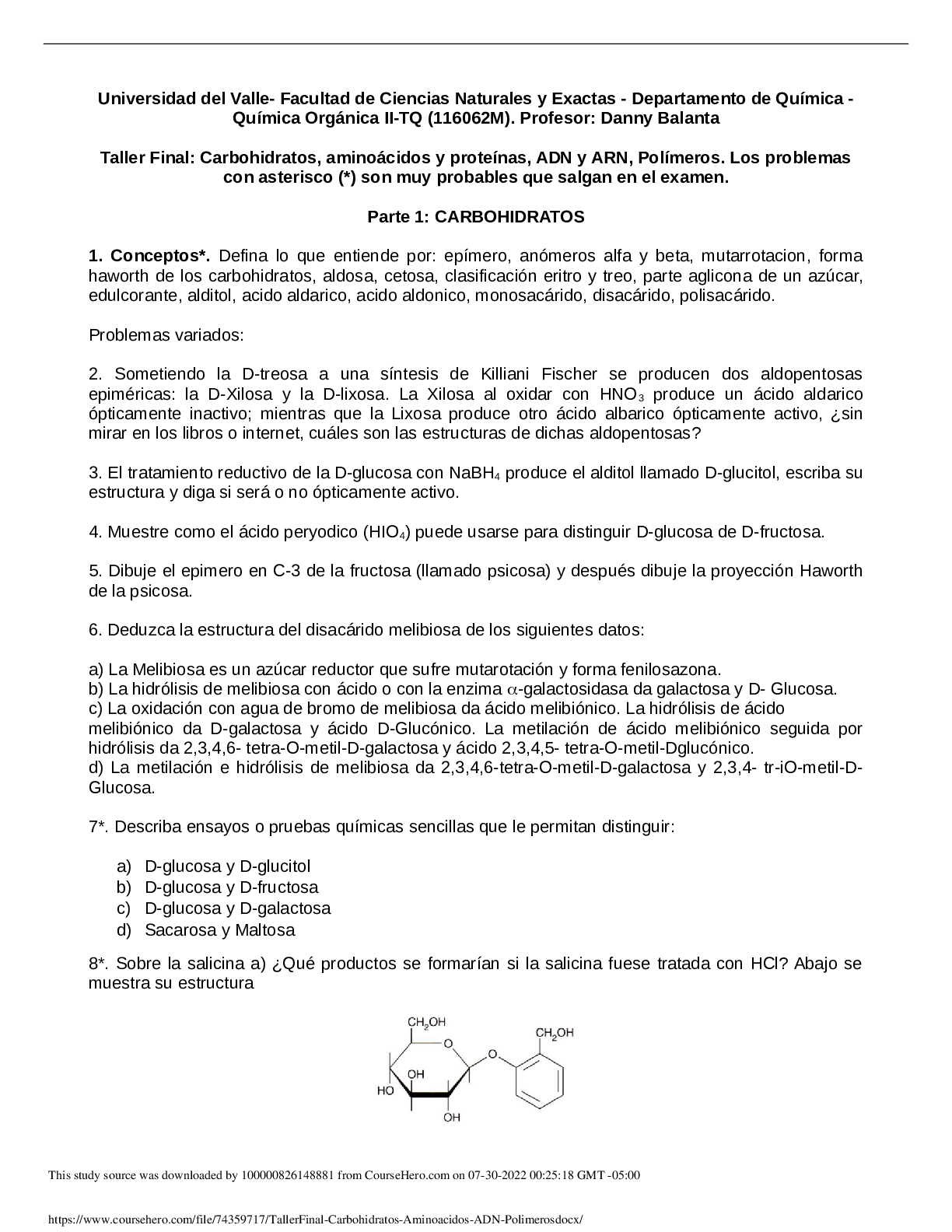
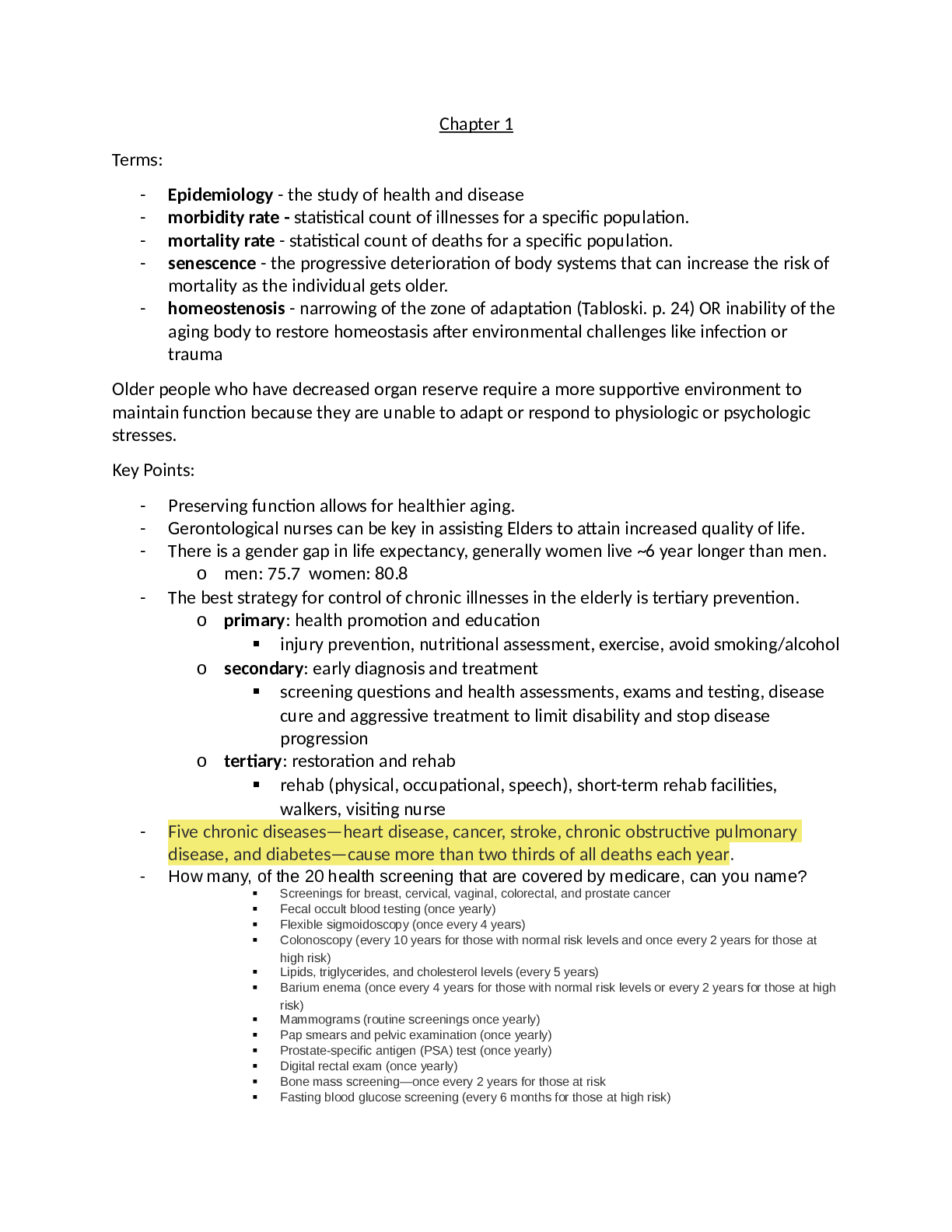


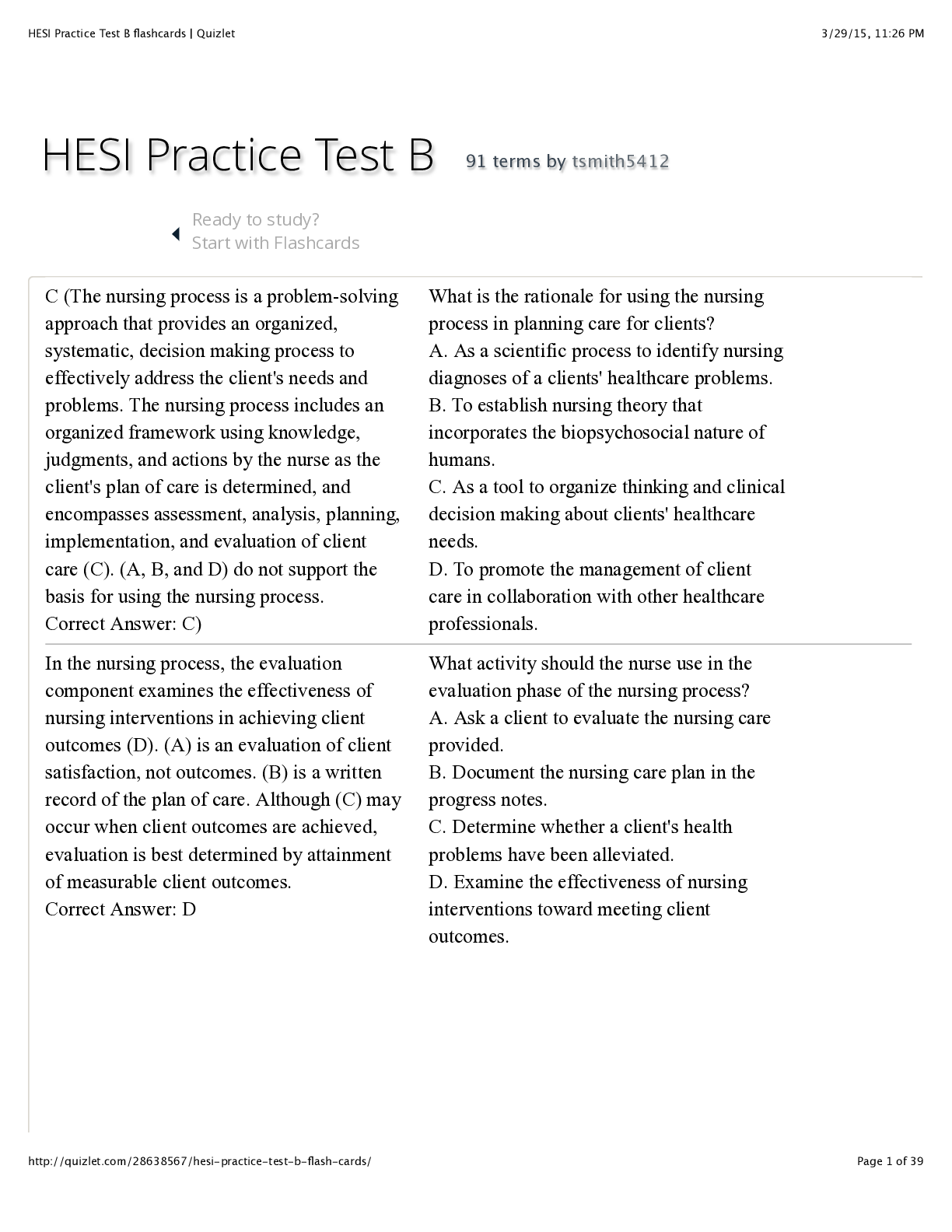


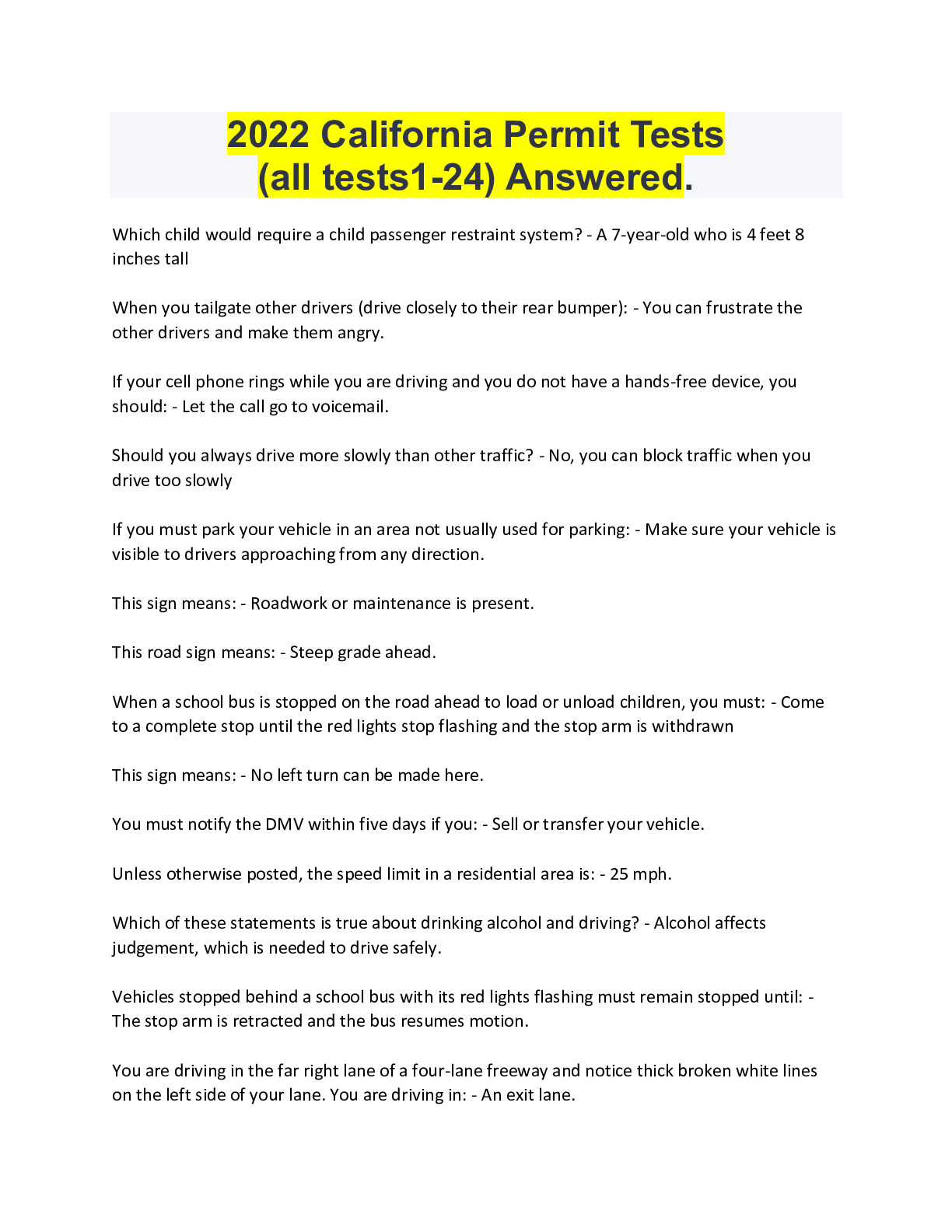

.png)
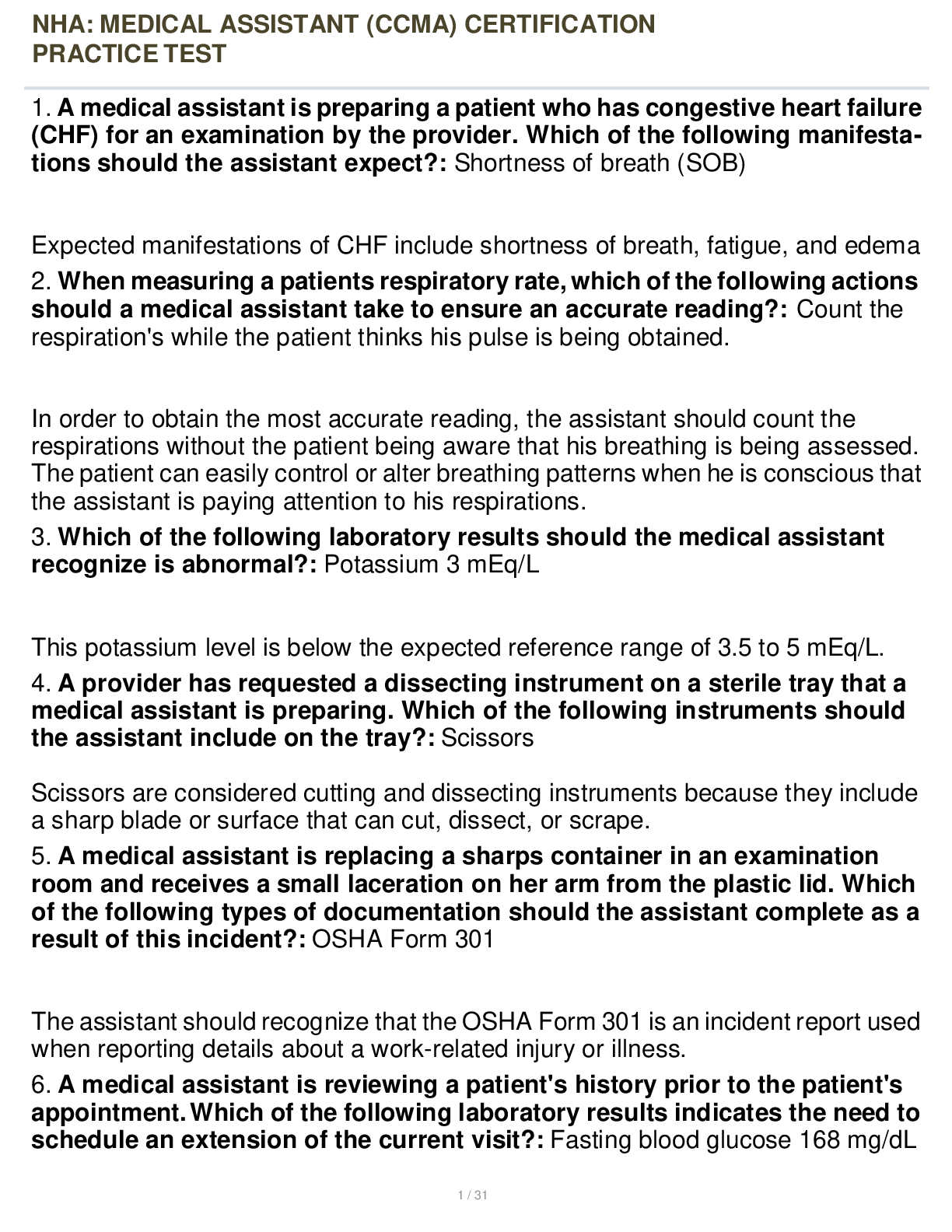
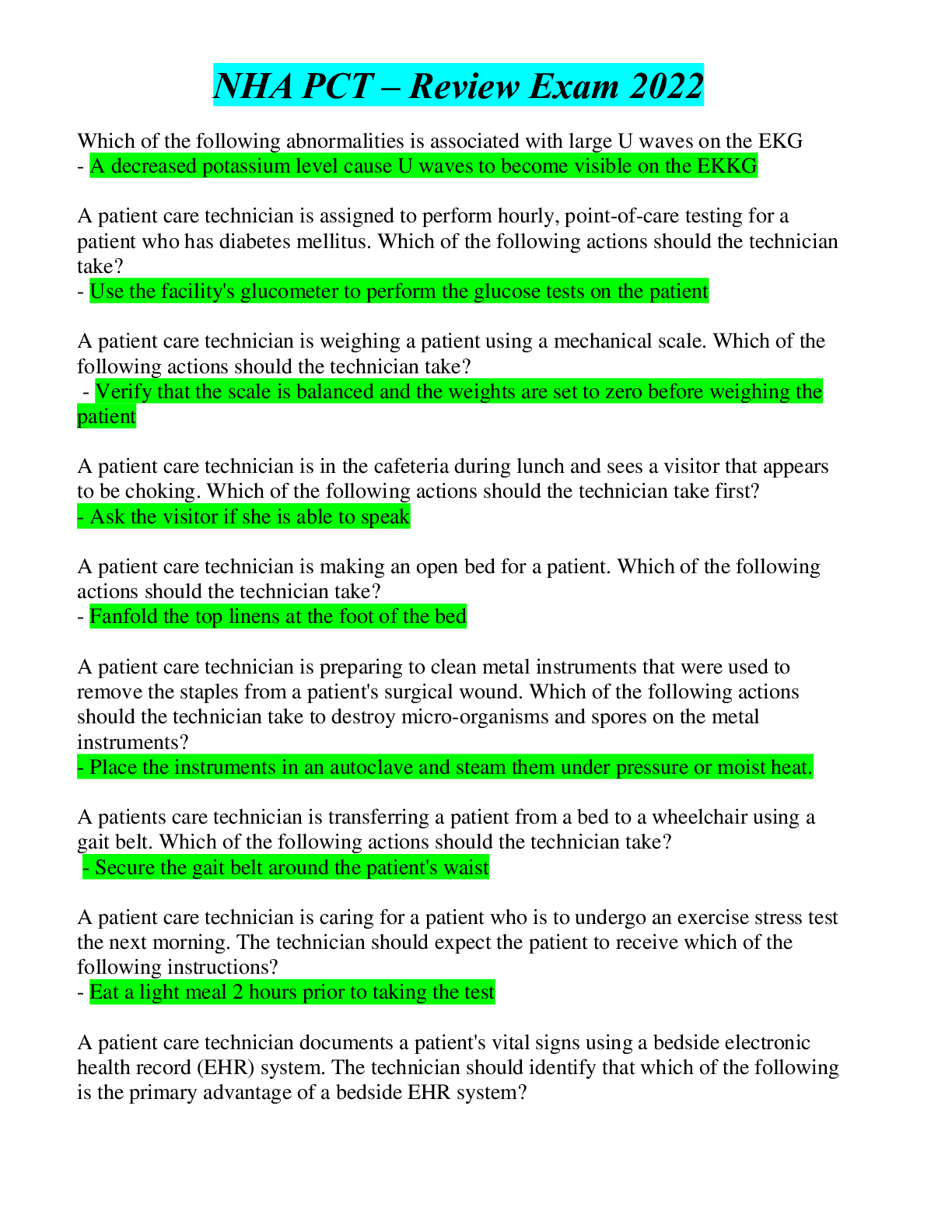
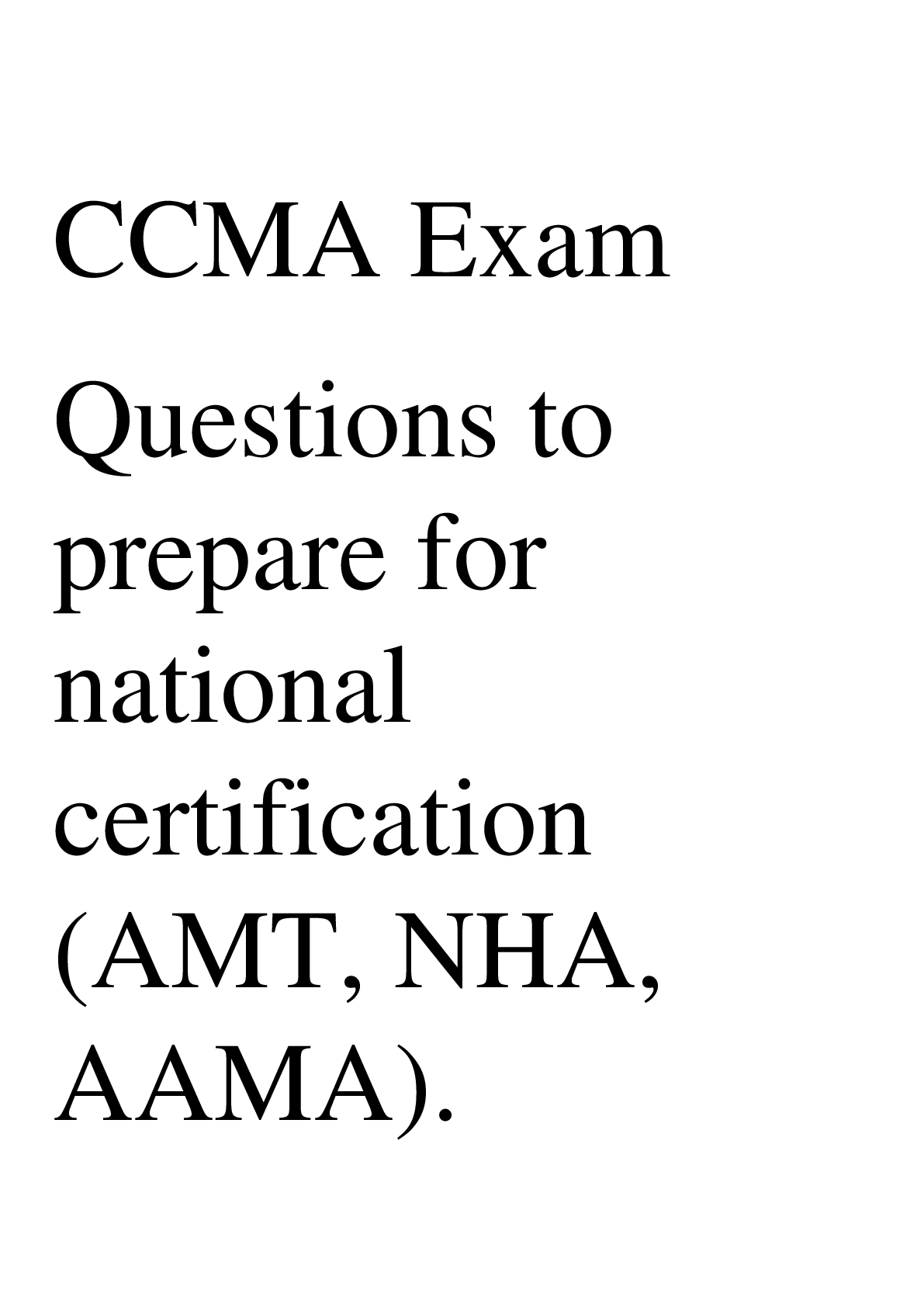
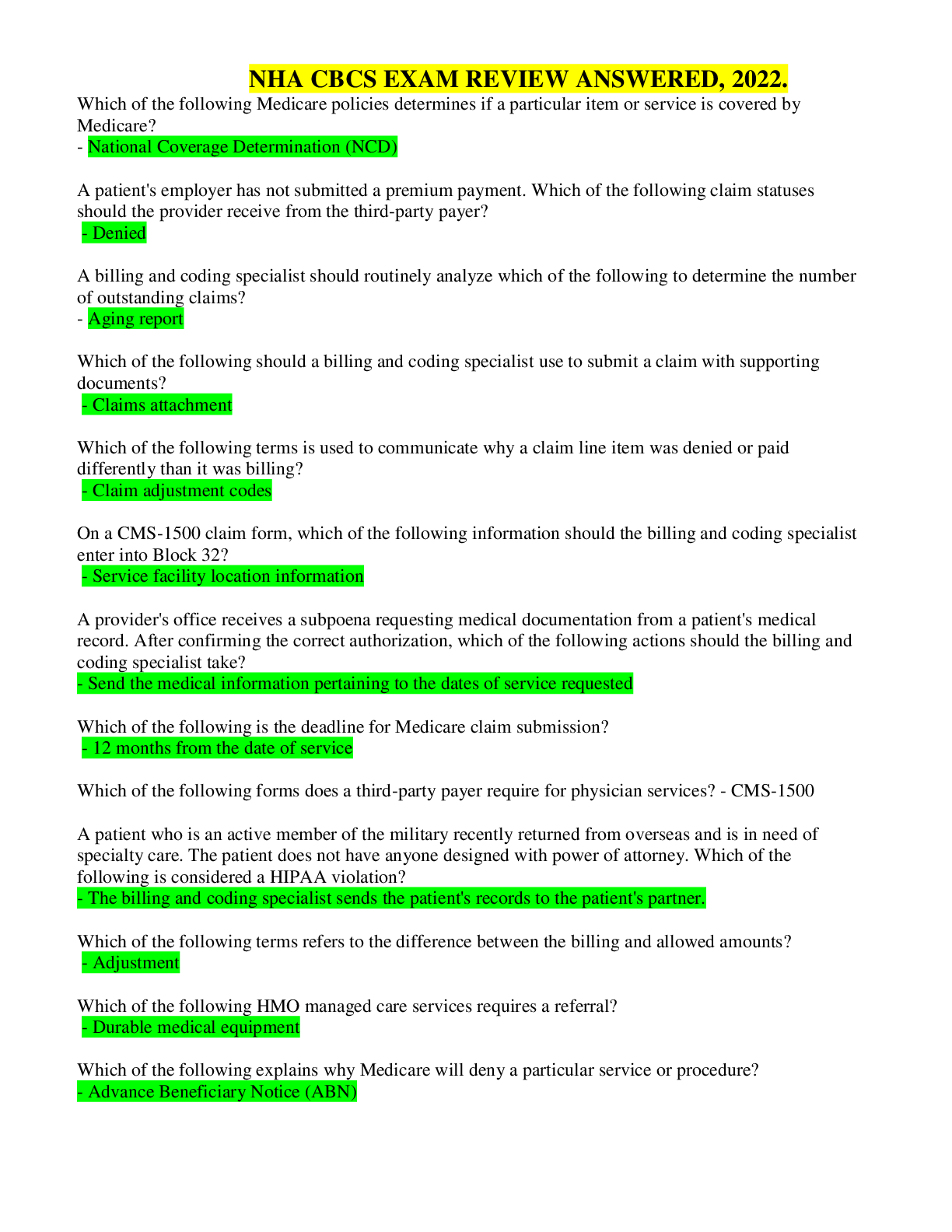
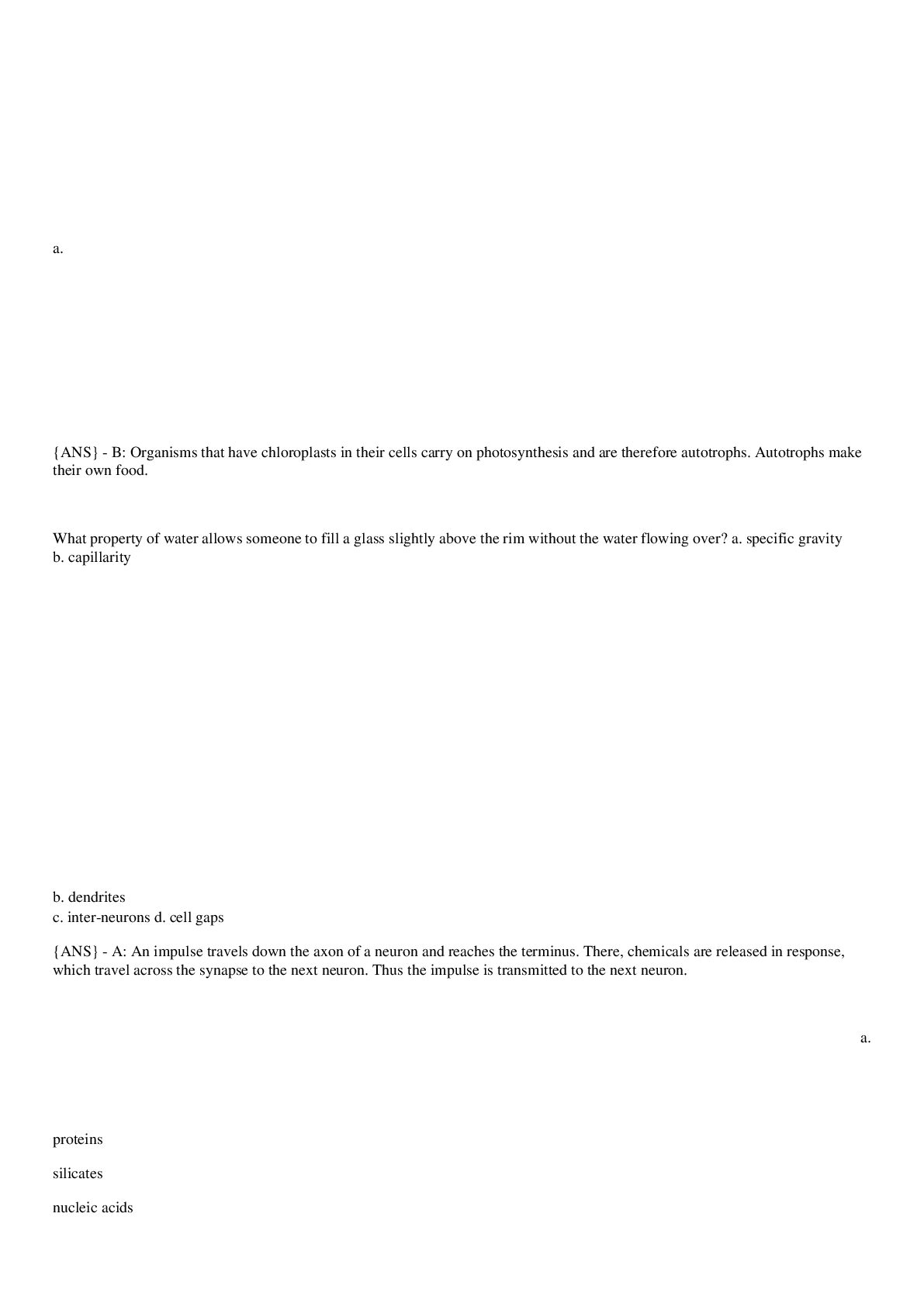

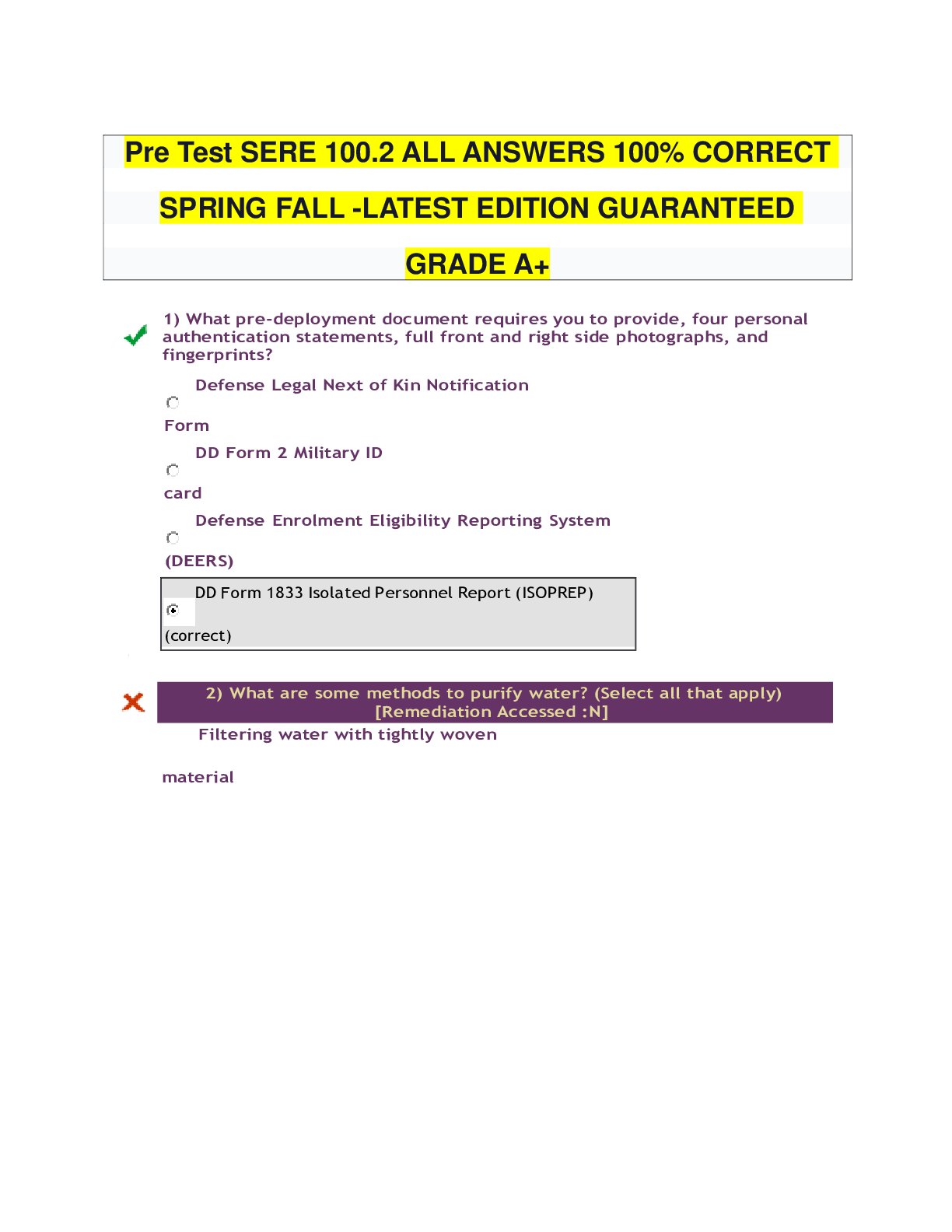

.png)

